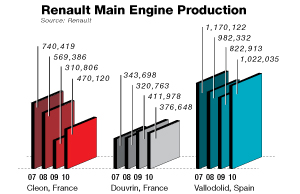
PARIS – Renault is investing in a new engine production line in Pitesti, Romania, for the 3-cyl. version of its next-generation gasoline engine.
By 2015, the auto maker expects that engine and a 4-cyl. to be manufactured in Spain to power 85% of its gasoline cars.
Renault says the new downsized engines, a 0.9L 3-cyl. and 1.2L 4-cyl., will cut carbon-dioxide emissions by 30-40 g/km, compared with the 4-cyl. mills they will replace.
The 4-cyl. H5 engine, making 115 hp, goes into production at Renault’s biggest engine plant in Valladolid, Spain, in 2012. The 3-cyl. H4 engine, making 90 hp, will be built in 2013 with new equipment at the Dacia plant in Romania. Dacia now makes 1.4L and 1.6L port-injected gasoline engines.
Nissan leads the Renault-Nissan Alliance in developing gasoline engines, and the new Renault engines are for the alliance engines, a spokesman says.
However, the Renault mills will differ significantly from the Nissan HR family of new direct-injection gasoline engines, as Renault’s 1.2L uses four cylinders, while Nissan’s uses three.
This summer in Europe, the Nissan Micra will get a 3-cyl. 1.2L HR12DDR supercharged engine emitting only 95 g/km of CO2, based on the naturally aspirated 1.2L HR12DE in the Nissan March in Japan.

Renault says it is not yet releasing information on the stroke and bore of its new engines. The Nissan HR12DE has a stroke of 83.6 mm and bore of 78.0 mm.
The new Renault engines will meet Euro 5 emissions rules when launched and Euro 6 when it takes effect in 2014, a Renault spokesman says.
The engines will replace the 1.6L K4 and K7 engines commonly used in the A, B and C segments for cars from the Twingo and Clio to the Scenic and Megane, as well as the Dacia Logan family.
The current 1.2L D4F family of gasoline engines, making 60-80 hp, will continue in production as entry-level mills in the same cars. Some 8,400 of these engines are produced each week at a joint Renault-PSA Peugeot Citroen factory in Douvrin, France.
As the D4F ages in coming years, production will decline, a spokesman says, but it still will meet Euro 5 emissions requirements. Renault says the new engines will bring the CO2 output of several vehicles below 100 g/km.
A general improvement is apparent. For example, the current Clio with a 1.6LI-4 making 112 hp emits 179 g/km of CO2. Reducing that by 35 g/km would put the car below the 2010 average in Europe of 146 g/km.
Renault vehicles emitting the least CO2 today all are diesels. But in the future, aftertreatment for oxides of nitrogen is expected to make diesels too expensive for smaller cars, which has encouraged the development of downsized direct-injection gasoline engines.




